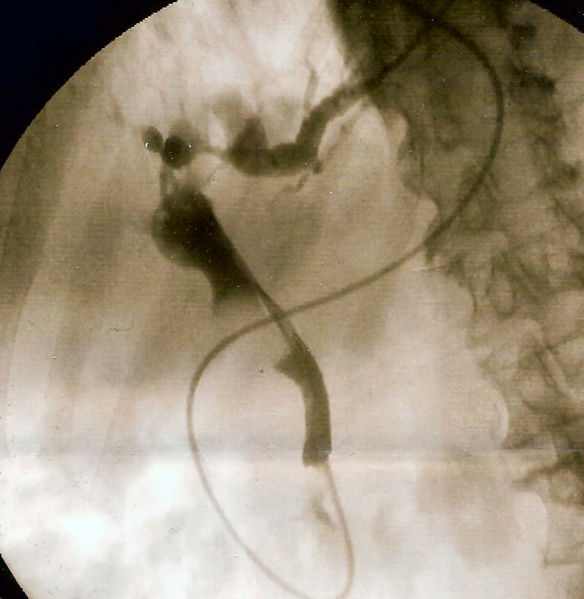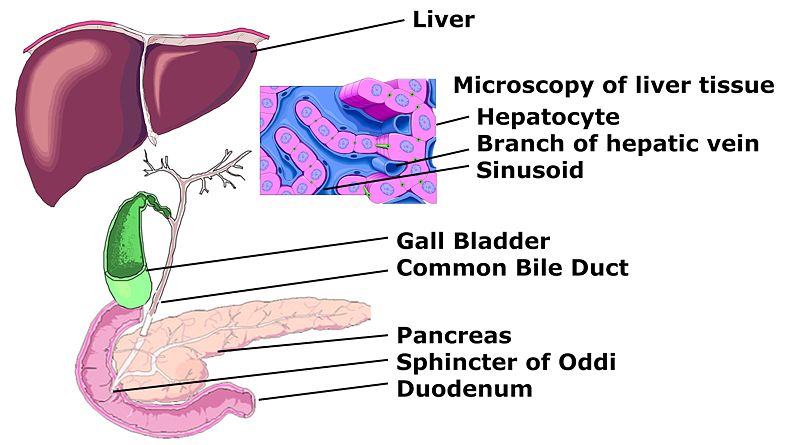Hepatology
Overview

Hepatology is the branch of medicine that incorporates study of liver, gallbladder, biliary tree and pancreas as well as management of their disorders. Etymologically the word Hepatology is formed of ancient Greek hepar(ηπαρ) or hepato-(ηπατο-) meaning ' liver' and suffix -logia(-λογια) meaning 'word' or 'speech'. Although traditionally considered a sub-specialty of gastroenterology, rapid expansion has led in some countries to doctors specialising solely on this area, who are called hepatologists.
Diseases and complications related to viral hepatitis and alcohol are the main reason for seeking specialist advice. One third of world population has been infected with Hepatitis B virus at some point in their life. Although most of them would clear the virus from the body, approximately 350 million have become persistent carriers. Up to 80% of liver cancers can be attributed to either hepatitis B or Hepatitis C virus. In terms of number of mortality, the former is second only to smoking among known agents causing cancer. Hopefully, widespread implementation of vaccination and strict screening before blood transfusion are going to lower the infection rate in future.
However in many countries overall alcohol intake is on the rise and as one can expect, number of people with cirrhosis and other related complications are increasing.

Scope of the specialty
As for many medical specialties, patients are most likely to be referred by family physicians( i.e. GP) or by doctors from different disciplines. The reasons might be:
- Jaundice
- Gastrointestinal bleeding from portal hypertension related to liver damage
- Abnormal blood test suggesting liver disease
- Enzyme defects leading to bigger liver in children commonly named storage disease of liver
- Hepatitis virus positivity in blood, perhaps discovered on screening blood tests
- Ascites or swelling of abdomen from fluid accumulation, commonly due to liver disease but can be from other diseases like heart failure
- All patients with advanced liver disease e.g. cirrhosis should be under specialist care
- To undergo ERCP for diagnosing diseases of biliary tree or their management
- Fever with other features suggestive of infection involving mentioned organs. Some exotic tropical diseases like hydatid cyst, kala-azar or schistosomiasis may be suspected. Microbiologists would be involved as well
- Damage to liver from other toxins like drugs. Paracetamol overdose is common
- Systemic diseases affecting liver and biliary tree e.g. haemochromatosis
- Follow up of liver transplant
- Pancreatitis - commonly due to alcohol or gall stone
- Cancer of above organs. Usually multi-disciplinary approach is under taken with involvement of oncologist and other experts.
History
Evidence from autopsies on Egyptian mummies suggest that liver damage from parasitic infection Bilharziasis was widespread in the ancient society.[1] It is possible that Greeks might be aware of liver's ability to exponentially duplicate as illustrated by Prometheus story. However knowledge about liver diseases in antiquity was some what sketchy. Most of the important advances in the field were made in last 50 years.
- In 400 BC Hippocrates mentioned liver abscess in apporium .
- Roman anatomist Galen thought liver is the principle organ of the body. He also identified its relationship with gallbladder and spleen.[2]
- Around 100CE Areteus of cappadoca wrote on jaundice[3]
- In mideaval period Avicenna noted the importance of urine in diagnosing liver conditions.
- 1770 French anatomist Antoine Portal, noted bleeding due to oesophageal varices,[4]
- 1844 Gabriel Valentin showed pancreatic juices break down food in digestion.
- 1846 Justus Von Leibig discovered pancreatic juice tyrosine[3]
- 1862 Austin Flint described the production of "stercorin".
- 1875 Victor Charles Hanot described cirrhotic jaundice and other diseases of liver[5]
- In 1958, Moore developed a standard technique for canine orthotopic liver transplantation.[6]
- The first human liver transplant was performed in 1963 by Dr. Thomas E. Starzl on a 3-year-old male afflicted with biliary atresia after perfecting the technique on canine livers.[7], [8]
- Baruch S. Blumberg discovered Hepatitis B virus in 1966 and developed first vaccine against it 1969. He was awarded the Nobel Prize in Physiology or Medicine 1976.[9]
Disease classification
1. International Classification of Disease (ICD 2007)/ WHO classification:
2. MeSH (medical subject heading):
- G02.403.776.409.405 same as "Gastroenterology"
- C06.552 Liver Diseases
- C06.130 Biliary Tract Diseases
- C06.689 Pancreatic diseases
3.National Library of Medicine Catalogue (NLM classification 2007):
Also see Hepato-biliary diseases
Important procedures
- Endoscopic retrograde cholangiopancreatography(ERCP)
- Transhepatic pancreato-cholangiography(TPC)
- Transjugular intrahepatic portosystemic shunt(TIPSS)
Publication
- The American Journal of Gastroenterology (Journal of the American College of Gastroenterology)
- The American Journal of Physiology - Gastrointestinal and Liver Physiology
- Archives of Gastroenterohepatology
- Comparative Hepatology
- Current Hepatitis Reports
- European Journal of Gastroenterology and Hepatology
- Gastroenterología y Hepatología
- Gastroenterology (journal of the American Gastroenterological Association)
- Hepatobiliary & pancreatic diseases international : HBPD INT (First Affiliated Hospital, Zhejiang University School of Medicine, China)
- Hepatology (journal of the American Association for the Study of Liver Diseases)
- HPB
- Journal of Gastroenterology and Hepatology
- HPB Surgery
- Journal of Hepato-Biliary-Pancreatic Surgery
- Journal of Hepatology (journal of the European Association for the Study of Liver Diseases)
- Journal of Viral Hepatitis
- Liver
- Liver Transplantation (from the American Association for the Study of Liver Diseases)
- Nature clinical practice. Gastroenterology & hepatology.
Societies
- American Association for the Study of Liver Disease
- American College of Gastroenterology
- American Gastroenterological Association
- American Hepato-Pancreato-Biliary Association
- American Liver Society
- Austrian Society of Gastroenterology and Hepatology
- British Society of Paediatric Gastroenterology, Hepatology and Nutrition
- Canadian Association for the Study of the Liver
- Czech Society of Hepatology
- Danish Association for the Study of the Liver
- European Association for the Study of the Liver
- European Society of Paediatric Gastroenterology, Hepatology and Nutrition
- French Association for the Study of the Liver
- International Hepato-Pancreato-Biliary Association
- International Liver Transplantation Society
- Israel Association for the Study of the Liver
- North American Society for Pediatric Gastroenterology, Hepatology and Nutrition
- Society for Surgery of the Alimentary Tract
- Spanish Society of Pediatric Gastroenterology, Hepatology and Nutrition
- Swiss Association for the Study of the Liver
- Turkish Association for the Study of the Liver
References
- ↑ Rosalie David A, Contis G (1996). "Paleopathology on schistosomiasis in Egyptian mummies". Parasitol. Today (Regul. Ed.). 12 (4): 167. PMID 15275234.
- ↑ "History of Liver, Gallbladder, and Spleen". Retrieved 2007-05-18.
- ↑ 3.0 3.1 H S.J. Lee (Editor). Dates in Gastroenterology: A Chronological Record of Progress in Gastroenterology over the Last Millennium (Landmarks in Medicine). Informa Healthcare. ISBN 1-85070-502-X.
- ↑ Moodley J, Singh B, Lalloo S, Pershad S, Robbs JV (2001). "Non-operative management of haemobilia". The British journal of surgery. 88 (8): 1073–6. doi:10.1046/j.0007-1323.2001.01825.x. PMID 11488792.
- ↑ "Victor Charles Hanot (www.whonamedit.com)". Retrieved 2007-05-18.
- ↑ "eMedicine - History of Pediatric Liver Transplantation : Article by Beth A Carter, MD". Retrieved 2007-05-18.
- ↑ "History of Liver Transplantation". Retrieved 2007-05-18.
- ↑ STARZL TE, MARCHIORO TL, VONKAULLA KN, HERMANN G, BRITTAIN RS, WADDELL WR (1963). "HOMOTRANSPLANTATION OF THE LIVER IN HUMANS". Surgery, gynecology & obstetrics. 117: 659–76. PMID 14100514.
- ↑ "Baruch S. Blumberg - Autobiography". Retrieved 2007-05-18.
ur:طب جگر ca:Hepatologia de:Hepatologie it:Epatologia nl:Hepatologie nn:Hepatologi Template:WH Template:WikiDoc Sources